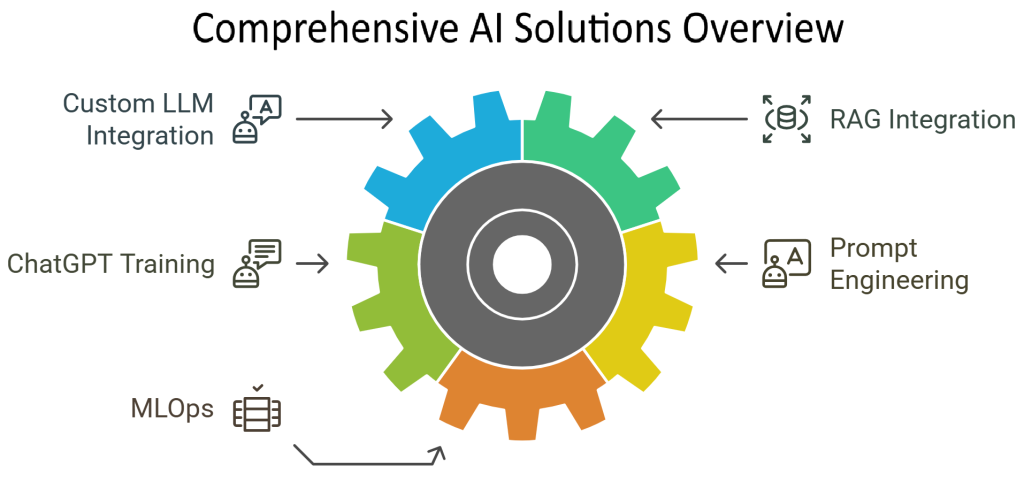
1. Dedicated AI Agents
Create custom AI agents to automate repetitive workflows, streamline operations, and generate significant time and cost savings across your organization.
What’s Involved
- Design purpose-built AI agents tailored to specific business processes and tasks.
- Integrate these agents with your existing systems and data sources.
- Implement governance frameworks to monitor agent performance and maintain oversight.
Key Outcomes
- Dramatic reduction in manual, repetitive tasks freeing your team for higher-value work.
- Improved operational efficiency with 24/7 automated processes that never fatigue.
- Measurable ROI through reduced labor costs and faster process completion times.
2. Custom LLM Integration
Embed Large Language Models (LLMs) like GPT or LLaMA, into your workflows, customizing them for specific industries or domains.
What’s Involved
- Fine-tune existing LLMs with domain-specific data.
- Develop APIs or microservices to seamlessly embed the model into your existing applications.
- Ensure compliance with enterprise security and performance standards.
Key Outcomes
- Improved productivity through AI-augmented workflows (e.g., content generation, summarization).
- Consistent, domain-relevant model responses aligned with your brand voice.
- Scalable solutions that can handle high-volume requests as AI adoption expands.
3. Retrieval-Augmented Generation (RAG) Integration
Leverage external data sources (knowledge bases, document stores) alongside an LLM to generate up-to-date, accurate content on demand.
What’s Involved
- Set up a document store or vector database for real-time retrieval.
- Build a retrieval pipeline that supplies the most relevant text snippets to the LLM.
- Configure the system to ensure AI responses are always grounded in current, factual data.
Key Outcomes
- Real-time access to evolving data (e.g., product catalogs, knowledge bases, policy updates).
- Reduced “hallucinations” by anchoring AI outputs in authoritative information sources.
- Quick knowledge-base updates without needing to retrain the entire model.
4. Conversational AI
Develop conversational AI solutions—like chatbots or virtual assistants—for customer support, internal helpdesks, and interactive user experiences.
What’s Involved
- Adapt ChatGPT (or similar models) for your customer support, sales, or internal Q&A scenarios.
- Design natural conversation flows (handling small talk vs. domain queries).
- Curate training data to mirror real-world user interactions and maintain your brand tone.
Key Outcomes
- Enhanced customer experiences with 24/7 automated support.
- Reduced workload on human agents, allowing them to focus on more complex tasks.
- Consistent, on-brand conversational style that represents your company effectively.
5. Prompt Engineering & Model Fine-Tuning
Optimize prompt structures and fine-tune models to consistently deliver highly relevant AI outputs.
What’s Involved
- Craft prompt templates to reliably generate desired AI responses.
- Implement parameter-efficient fine-tuning for cost-effective iterations.
- Test and refine various prompt strategies to optimize accuracy, relevance, and tone.
Key Outcomes
- Significantly improved AI performance with fewer irrelevant or confusing outputs.
- Faster iteration cycles to adapt the AI solution as your needs evolve.
- Cost savings by minimizing extensive retraining of large models.
6. MLOps & Deployment
Manage the entire machine learning lifecycle—from continuous integration to large-scale deployment, ongoing monitoring, and updates.
What’s Involved
- Develop pipelines for machine learning models to ensure smooth deployments.
- Monitor production performance (e.g., drift detection, performance metrics, logging).
- Automate updates, rollbacks, and version control for models and data.
Key Outcomes
- A reliable, scalable AI infrastructure with minimal downtime.
- Continuous improvements to model accuracy via automated retraining or updates.
- Clear oversight of model versions, ensuring auditability and compliance.




